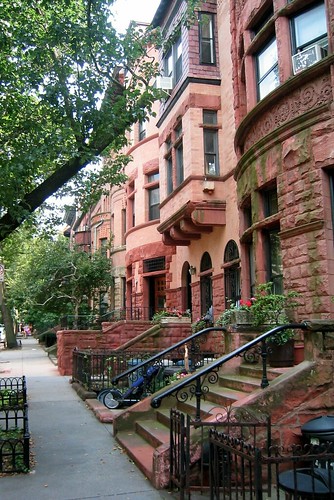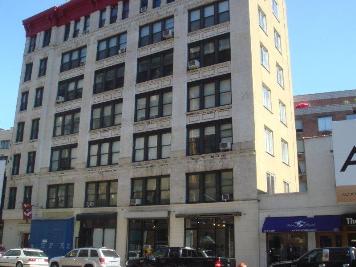Manhattan is not the center of the universe.
Okay, it is the center of the universe. But there are plenty of reasons to be just a little bit away—close enough so you can get there when you want to, but not right in the middle of the heavy traffic one finds at the crossroads of the world.
A lot of those reasons are in Park Slope, the parallelogram-shaped area in Brooklyn defined by Flatbush Avenue and the Prospect Expressway, Prospect Park West and 4th Avenue.
Prospect Park runs along its long eastern border, gorgeous and green, designed by Frederick Law Olmsted and Calvert Vaux. By way of rehearsal, they had designed Central Park.

Brownstoner photograph
You'll find charming little gathering places like Sweet Melissa Patisserie on 7th Avenue near 1st Street, which offers pastries so light they float off your plate if you don’t hold them down.
And there are excellent restaurants including but not limited to Rose Water, for locavores, on Union Street between 5th and 6th Avenues, and al di la trattoria on 5th Avenue near Carroll Street, where you can enjoy saltimbocca alla romana for a trifling $17.00, and braised rabbit with black olives and polenta for $25.
But I was going to talk about townhouses.
Park Slope is the home of the genuine brownstone. Yes, I know there are those who will casually refer to an 1823 federal style brick row house as a brownstone. There is a special place in hell reserved for these people.
But in Park Slope, you’ll find block after tree-lined block of beautiful and historic examples of the real thing, far more than on Manhattan’s upper west side, many with much of their original detail, a few with all of it.
Most of a five story mansion on Prospect Park West of more than 5000 square feet appears to have rested untouched since as early as the 1920s. The rooms are of a magnificent scale, the paneling and floors are for the most part intact.
Most of a five story mansion on Prospect Park West of more than 5000 square feet appears to have rested untouched since as early as the 1920s. The rooms are of a magnificent scale, the paneling and floors are for the most part intact.
Montgomery Place

FlickR
Most were built in the 1880s and ‘90s when Park Slope became seriously popular after the Brooklyn Bridge opened in 1883. The 1890 census showed Park Slope to be the richest community in the United States, and the houses built in this era reflect that.
The predominant style is Neo-Grec, a late version of Greek Revival. Brownstoner.com says “Like the Italianate style, with which it is often combined, the Neo-Grec style row house has a smooth brownstone front, with a pronounced deep cornice, heavy entryway and window details…….Neo-Grec is very masculine in its severity, with angular incised lines and forms, geometric and precise.
"The curved window and door frames [have] squared off edges, the large lintels equally large rectangular blocks. On the steep steps, the large balusters end in squared off cast iron and stone newel posts, with incised ornament, and geometric detail.
"The most striking and signature aspect of Neo-Grec brownstone architecture is the incised carved detail, appearing on window ledges, door frames, and most grandly and beautifully, on the flat surface of the brownstone building. The two most popular styles were an incised flower and vine design…” http://www.brownstoner.com/blog/2010/01/walkabout-archi/#graphic1-2 for more on this.
Urban sprawl and declining local industries led to the decline of Park Slope in the mid-20th century, but in the ‘60s and ‘70s, young people and artists began converting what had often become rooming houses back to single and two or three family homes. Thus began Park Slope’s renaissance.
Today, the median age is 34 and the median income is just shy of $100,000 a year.
Prices for townhouses in Park Slope are minuscule compared to prices for similar houses in Manhattan. Some recent sales of single family houses:
address | price | sale date | square feet | price per square foot |
375A 12 STREET | $2,200,000 | 6/14/11 | 1764 | $1,247 |
420 7 STREET | $1,620,000 | 6/13/11 | 1552 | $1,044 |
387 6 STREET | $1,950,000 | 6/10/11 | 1920 | $1,016 |
532 3 STREET | $2,750,000 | 8/31/11 | 2730 | $1,007 |
369 8 STREET | $2,000,000 | 8/23/11 | 2208 | $906 |
395 7 STREET | $1,850,000 | 5/2/11 | 2295 | $806 |
158 ST JOHN'S PLACE | $3,220,000 | 7/29/11 | 4225 | $762 |
106 LINCOLN PLACE | $2,528,000 | 9/7/11 | 3240 | $780 |
104 LINCOLN PLACE | $2,400,000 | 6/1/11 | 3240 | $741 |
621 3 STREET | $3,050,000 | 5/25/11 | 4152 | $735 |
355 14 STREET | $1,476,000 | 7/29/11 | 2112 | $699 |
588 5 STREET | $2,500,000 | 7/6/11 | 3744 | $668 |
380A 6 STREET | $1,095,000 | 8/25/11 | 1680 | $652 |
311A 15 STREET | $1,315,000 | 9/8/11 | 2160 | $609 |
235 14 STREET | $650,000 | 8/9/11 | 1304 | $498 |





